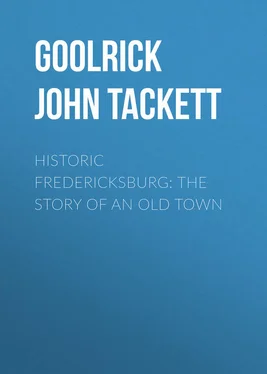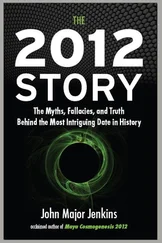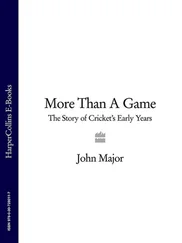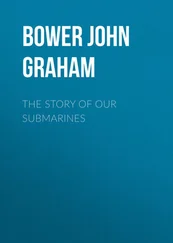John Goolrick - Historic Fredericksburg - The Story of an Old Town
Здесь есть возможность читать онлайн «John Goolrick - Historic Fredericksburg - The Story of an Old Town» — ознакомительный отрывок электронной книги совершенно бесплатно, а после прочтения отрывка купить полную версию. В некоторых случаях можно слушать аудио, скачать через торрент в формате fb2 и присутствует краткое содержание. Жанр: История, foreign_antique, foreign_prose, на английском языке. Описание произведения, (предисловие) а так же отзывы посетителей доступны на портале библиотеки ЛибКат.
- Название:Historic Fredericksburg: The Story of an Old Town
- Автор:
- Жанр:
- Год:неизвестен
- ISBN:нет данных
- Рейтинг книги:3 / 5. Голосов: 1
-
Избранное:Добавить в избранное
- Отзывы:
-
Ваша оценка:
- 60
- 1
- 2
- 3
- 4
- 5
Historic Fredericksburg: The Story of an Old Town: краткое содержание, описание и аннотация
Предлагаем к чтению аннотацию, описание, краткое содержание или предисловие (зависит от того, что написал сам автор книги «Historic Fredericksburg: The Story of an Old Town»). Если вы не нашли необходимую информацию о книге — напишите в комментариях, мы постараемся отыскать её.
Historic Fredericksburg: The Story of an Old Town — читать онлайн ознакомительный отрывок
Ниже представлен текст книги, разбитый по страницам. Система сохранения места последней прочитанной страницы, позволяет с удобством читать онлайн бесплатно книгу «Historic Fredericksburg: The Story of an Old Town», без необходимости каждый раз заново искать на чём Вы остановились. Поставьте закладку, и сможете в любой момент перейти на страницу, на которой закончили чтение.
Интервал:
Закладка:
In the Indian wars of 1755-57, Fredericksburg became an important depot and rendezvous for troops. Recruits, provisions, supplies and ordnances were sent to the town in quantities, and on April 15th, 1757, Governor Dinwiddie ordered Colonel George Washington to send two hundred men there to be “Thence sent by vessels to South Carolina, to treat with curtesy the Indians at Fort London, and to send them out in scalping parties with such number of men as you can spare.”
But now the peaceable growth and prosperity of the village were to be halted. Dissatisfaction with the government in England began to grow, and there were murmurings of discontent and resentment, not by any means indulged in by all the citizens, for large numbers were still utterly loyal to the Crown, and those who opposed its policies congregated to themselves, meeting in secret or standing in little groups about the streets to give vent to their feelings.
One well-known place for the meeting of “Revolutionists” was the Rising Sun tavern still standing in good order, at that time kept by “Mine Host,” George Weedon. This famed old Tavern is told of in another chapter. It is almost certain that at this tavern the rough draft was made of a resolution to be later passed in a public town meeting, which was tantamount to a declaration of independence, and which was passed twenty-one days before the famous Mecklenburg declaration and more than a year before that of the American congress.
These resolutions were adopted on the 29th day of April, 1775, amidst the greatest public excitement. News of the battle of Lexington, fought on the 20th of April, and of the removal by Lord Dunmore of twenty barrels of powder from the public magazine at Williamsburg to the English frigate “Fowey,” then lying near Yorktown, which occurred one day after the battle of Lexington, had just reached Fredericksburg. Immediately the citizens showed their indignation. More than six hundred men from the town and the surrounding country armed themselves and sent a courier to General Washington, then at Williamsburg, offering their services in defense of the Colonies. Delegates were also dispatched to Richmond to ascertain the true state of affairs, and to find out at what point the men should report. The men stayed under arms and in readiness to move at short notice until General Washington transmitted a message, advising that they restrain from any hostilities until a congress could be called to decide upon a general plan of defense. This advice was received by a council of more than a hundred men, representing fourteen companies (the number under arms having by this time grown), which decided by a majority of one to disperse for the present, but to keep themselves in readiness for a call. Many of them afterwards joined the armies of General Washington.
Material preparations for the conflict that everyone, even the Tories, now felt was certain, were made by the establishment at the town of the first small arms manufactury in America, which was located on what now is known as Gunnery Green. Colonel Fielding Lewis, brother-in-law of General Washington, was one of the commissioners in charge of the gunnery and active in its management.
With the coming of the Gunnery, and the formation of companies of troops, the peaceful atmosphere of Fredericksburg quickly changed to one of a militaristic aspect. Recruits drilled in the street, the manufacture of arms was rushed, supplies were received and stored, couriers, with news from other parts of the country, dashed in to acquaint the eager townspeople with events, and those loyal to the Colonies went bravely about with every kind of war preparation, while those inclined to Toryism kept quiet and to themselves, or moved away with their families, hoping, and probably succeeding in many cases, in reaching England before the whole country was affected by the war, in which the part played by Fredericksburg and its citizens was of the utmost importance. The town gave to the Revolution an unusually large proportion of troops and many of the great leaders.
During the Revolution, although Fredericksburg men were the leaders of the Army, no fighting occurred here and the period was not one of danger for the town, but was one of anxiety for the inhabitants. Tarleton passed close to this city on his raid towards Charlottesville, and Lafayette and his men built the road still known as “The Marquis Road,” through the Wilderness toward Orange.
Recently three soldiers, whose uniform buttons testify they were Hessians, were dug up near Spotsylvania Court House. A prison camp existed about two miles from here on the Plank Road from which Washington recruited some artisans to do the interior decorating in the home of his beloved sister, Betty, at Kenmore.
Several Regiments went from Fredericksburg. General William Woodford (see sketch of life) was elected Commander of the first. Among his descendants are the late Marion Willis, Mayor Willis and Mr. Benj. Willis. General Hugh Mercer was chosen Commander of the third regiment, and James Monroe, of Fredericksburg (afterwards president) was Lieut. – Colonel, while Thomas Marshall, father of Chief Justice Marshall, was Major. The other Virginia Regiment was not recruited here. It was commanded by Patrick Henry.
Although it furnished two of the first three Virginia Regiments, and half of America’s Generals, as well as the Commanding General, Fredericksburg was not a war center. Its history during that period will be found in the lives of the men it produced, elsewhere in this book.
It did give most material aid by furnishing arms from the “Gunnery” of Col. Fielding Lewis, and was generous in its financial aid, and always ready for attack.
After the Revolution
The first mention of Fredericksburg in the annals of the new Republic is an act of the legislature in 1781, incorporating the town and vesting the powers of its government in the hands of a mayor and commonality, consisting of a council and board of aldermen. Courts were established and provision made for future elections of its officials.
The first mayor was Charles Mortimer, and the Board of Aldermen consisted of William Williams, John Sommerville, Charles Dick, Samuel Roddy and John Julien, who, together with the mayor, were also justices of the peace, and required to hold a hustings court monthly. John Legg was appointed sergeant of the court and corporation, and John Richards and James Jarvis constables. The town’s initial commonwealth’s attorney, John Minor, is said to have been the first man to offer in any legislative body of the country a bill for the emancipation of the slaves.
The first action of the court is interesting, especially in these times. It was giving license to five persons to conduct taverns, immediately followed by an act to regulate them by establishing prices for alcoholic, vinous and fermented beverages. There is no mention of opening or closing hours, Sunday selling, selling to minors or any of the later and stricter regulations, and the prices to be charged are in terms of pounds, or parts, per gallon. The American bar was unknown then and probably even in the taverns and tap rooms, little liquor was sold by the drink. Some of the prices established translated into dollars, were West Indian rum, per gallon, $3.34; brandy, $1.67; good whiskey, $1.00; good beer, $0.67 and so on.
Having taken care that the tavern keepers could not charge too much for drink, the court now provided that they should not over charge for food served, placing the score for a “single diet” at twenty-five cents, a most reasonable sum according to modern standards.
Читать дальшеИнтервал:
Закладка:
Похожие книги на «Historic Fredericksburg: The Story of an Old Town»
Представляем Вашему вниманию похожие книги на «Historic Fredericksburg: The Story of an Old Town» списком для выбора. Мы отобрали схожую по названию и смыслу литературу в надежде предоставить читателям больше вариантов отыскать новые, интересные, ещё непрочитанные произведения.
Обсуждение, отзывы о книге «Historic Fredericksburg: The Story of an Old Town» и просто собственные мнения читателей. Оставьте ваши комментарии, напишите, что Вы думаете о произведении, его смысле или главных героях. Укажите что конкретно понравилось, а что нет, и почему Вы так считаете.












